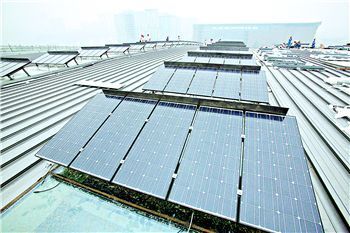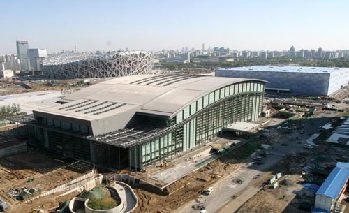
The solar cell panel on the top of the National Indoor Stadium.
 Bird's eye view of the National Indoor Stadium.
Bird's eye view of the National Indoor Stadium.
Committed to a "green" Olympics, Beijing has built its key Game's venues into not only showpieces among the most imaginative and impressive architectural feats in the world, but also energy-saving role models.
The National Stadium, known as the "Bird's Nest" for its unique latticework of interwoven steel, is considered a template for water conservation, with 70 percent of its supply coming from recycled water.
"The recycled water will be used to wash the racetrack and water the plants around the venue," said Li Jiulin, chief engineer of the stadium construction.
Li noted that 23 percent of the recycled water would be collected from rainfall, and the rest recycled from industrial waste-water and urban sewage.
In talking about the sophisticated rainwater re-use system fanning from the Bird's Nest, Li became excited when describing its intricate details.
"Through the system, rainwater that falls on the stadium's roof, playing field and its more than 20,000 square meters of surrounding area will be collected and channeled to a 12,000-cubic-meter pond.
"The water will then go through three screens of filtration -- quartz sand filtration, micro filtration and ultra filtration, to clear harmful elements."
Beside the Bird's Nest, the National Aquatics Center, or the "Water Cube," has also been designed into a comprehensive energy-saving building.
"Special measures have been imposed to reduce water consumption and sewage discharge," said Sun Hongzhuang, project manager with the China Construction First Division Group Construction and Development Co., Ltd,builder of the structure.
It is able to collect 10 million liters of rainwater, 70 million liters of bath water and 60 million liters of swimming-pool waste-water annually to wash the ground, flush toilets, supplement the water supply for the cooling tower and water the plants around the venue, Sun said.